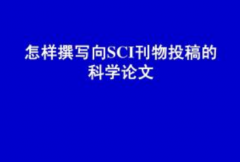土壤肥力论文发英文农业期刊的过程
英文论文的写作主要用于参加国际学术研讨会,促进中外学术文化交流。发表在国际学术刊物上,国际上共享科研成果,发表英语论文也达到学术交流的目的。英语论文的写作很有意义,对作者个人也很有帮助。如果作者能发表高水平的英语论文,将有助于升职和个人发展。那么土壤肥力论文发英文农业期刊的过程是什么?通常英文论文发表都会经历以下过程。

1.Submitted to Journal投稿
2.Manuscript received by Editorial Office,文章送达,证明投稿成功。
3.With editor,若投稿时未要求选择编辑,则先到主编处,主编会分派给副主编或者其他编辑。
4. With editor,后送审可能出现的两种状态(Decision Letter Being Prepared或Reviewers invited)
5. Under review审稿中,此过程的等待较为漫长。
6. Required Reviews Completed,表示审稿意见已经返回给编辑。
7. Evaluating Recommendation,评估审稿人的意见,随后你将收到编辑给你的decision。
8. Decision in process,等待稿件处理意见。
9. Minor revision/Major revision,小修或大修。至此问题一般不会太大,充分尊重审稿人和编辑的意见。
10. Revision Submitted to Journal,又开始了一个循环。
11. Accepted 接受
12.Reject 拒稿。
土壤肥力论文投稿期刊:
Paddy and Water Environment《水稻与水环境》的目标是推进水稻种植中与水和环境相关学科的科学和技术。范围包括农业工程中与水稻种植相关的科技方面,如灌溉和排水、水土保持、土地和水资源管理、灌溉设施和灾害管理、水稻多功能、农业政策、区域规划、生物环境系统、,水稻种植区的生态保护与恢复。
范例:The effects of a combined amendment on growth, cadmium adsorption by five fruit vegetables, and soil fertility in contaminated greenhouse under rotation system
Abstract / 摘要
Cadmium (Cd) exposure is related to a multitude of adverse health outcomes because food crops grown on Cd-polluted soil are widely consumed by the public. The present study investigates the different application techniques of a combined amendment (lime + zeolite + biochar + compost, LZBC) for soil Cd immobilization effect on growth performance, Cd uptake by the second season crops, and soil quality in greenhouse vegetable production (GVP) under a rotation system. Five fruit vegetables were cultivated as the second season crop in the same plots which have been used for pakchoi as the first season crop (with or without LZBC application). The results indicated that LZBC with the consecutive application (T3) promoted crops biomass and fruit yield the most, followed by LZBC with the second crop application (T2) and LZBC with the first crop application (T1). LZBC application showed increasing rhizosphere soil pH and improvement in soil fertility of all crops including available nitrogen, available phosphorus, available potassium, organic matter, and cation exchange capacity. LZBC had positive influences on soluble sugar, soluble protein, and vitamin C in edible parts of 5 vegetables. Cd contents in fruit, shoot, and root of eggplant, pimento, cowpea, and tomato except cucumber were reduced by adding LZBC. As for the economic performance, T3 had the highest output/input ratio in general. Overall, these results demonstrated that T3 was dramatically more effective for minimizing health risk, increasing production, and facilitating sustainable utilization of soil under the Cd-contaminated GVP system.










![[SCI干货]sci的共同通讯作者标注方法(附范例)](http://www.scizj.com/uploads/20221121//b637b435e2625a.jpg)

